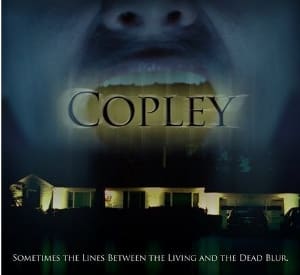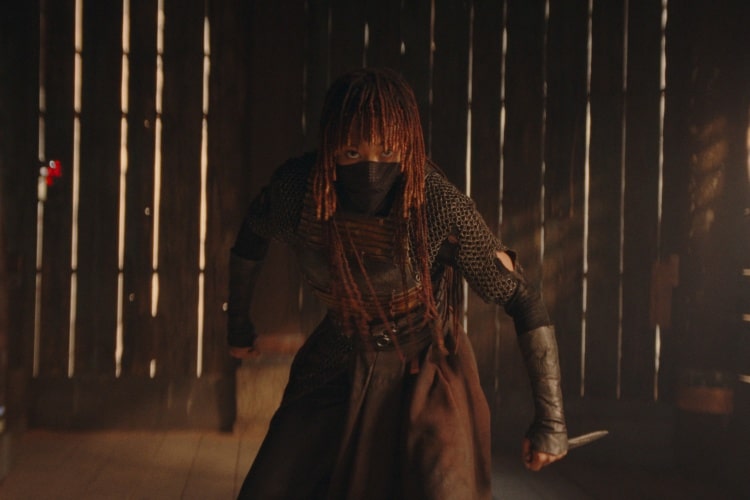“I See You!”
Main Cast: David Sullivan and Heather Pikas
Director: Alexander Pikas
It’s probably not a good sign that, at the halfway mark of this 70-minute movie, I’d seen a handful of really creepy and effective scenes but had yet to discern any kind of story.
The entirety of writer/director Alexander Pikas’s 2008 film Copley: An American Fairytale seems to be one couple’s hell night as they try to go to bed and sleep through the night. Insomnia, a crying baby, a nicotine fit, noises in the garage, getting locked in the shed, mysterious phone calls, oh and the ghosts of the former owners arguing in the sun room all work against the couple, Alex and Heather, to keep them up and lost in a maze of confusing haunting activity that, in the end, leads nowhere at all.
I’m not even sure how to write a synopsis for this movie: it really begins and ends nowhere. Alex and Heather fall asleep on the couch watching home movies of their daughter’s first few months. After going to bed, they’re woken by the baby crying, only when Alex goes to check on her, she’s sound asleep and the crying is coming from elsewhere in the house. Then he hears an adult sobbing and finds his wife in the garage, but then his wife comes out of the house to get him and the vision he saw of her crying is gone.
They go back to bed and get up again a little later to get a drink. Alex realizes he’s out of cigarettes and drives to the gas station down the street. While he’s gone, Heather sees an old man in the backyard, sneaking into the shed. When she can’t get Alex to answer his phone, Heather grabs a flashlight and goes to check it out herself–because that would EVER happen–and winds up locked in the shed.
Alex finds her when he gets home, but then they see an old couple arguing in the house, ghosts, so they grab the baby and flee to Alex’s dad’s house, only when they go inside they find themselves back in their house on Copley Lane. They try to unravel the mystery of what the ghosts were saying so Heather checks her sign language book–the male ghost is speaking in sign language–and mistakenly thinks they’re saying Alex killed them. She tries to leave with the baby, but Alex stops her and then … they go back to bed.
Then we get about four hours of flashbacks to when Alex and Heather were trying to buy the house from the Vassels, the couple who had lived there for the previous 40 years and who weren’t interested in selling. Alex hears the son yelling at his father asking how he could consider selling the house when it’s HIS house, then the couple die and the son sells to Alex and Heather.
Don’t ask; I stopped trying to follow the logic of this movie fifteen minutes in.
This movie was one big dreamscape of an experience, where things are shown to us, then later the details change–for instance, the contents of the fridge are different from one shot to another, even though this story takes place all in one night. At first I thought it was just lazy filmmaking, but in retrospect it could have been on purpose. We’ll never know.
Pikas was definitely trying to display a style of filmmaking here, but for the most part that style came about to the detriment of any substance. Sure, it’s visually interesting–for the most part–but overall if you deleted all the repetitious shots, mini-flashbacks, establishing shots, etc., we’d be left with a 30-40 minute movie instead of the 70 minute behemoth we got. And, man, does Pikas LOVE showing shots of the house and its furnishings.
And then when the third act is winding down, he lays it on pretty thick, practically giving us a roadmap of what’s going on to make sure he doesn’t lose us along the way. Don’t worry, dude, we got it. We see very clearly what’s going on. And if this were an original idea at all, it may carry some weight. But in the wake of so many other similar, and BETTER, movies with the same plot, this one just doesn’t thrill like it should.
The acting isn’t terrible. David Sullivan (Primer) as Alex has a few good moments but is ultimately not given much to do other than be the sometimes-loving but usually put upon husband, while director Pikas’s wife, Heather, as Alex’s wife Heather, gets the most screen time, all the best lines, and most of the action. I can’t fault him for it, she seems to have some definite acting chops, so it’s a wonder I haven’t seen her in more.
Then again, I said the acting wasn’t terrible. I never said it was great.
One thing I did appreciate a lot about this movie was the number of genuinely creepy moments. The crying baby scene at the beginning was seriously creepy, and the sound design and camera work on the woman in the garage were also very effective. Heather watching the old man snooping around her shed in the back yard worked very well, as did the old woman ghost leaning in close to Heather and telling her, “I see you!”
Scary stuff. It’s rare a movie provides so many honest scares, and even rarer still when they come from a movie as low-budget and DIY as this. Personally, I think it’s awesome a movie this small could work so well. At least when it comes to scaring the viewer. Or at least making them feel very uncomfortable, even if only for a few seconds.
So now comes the time when I have to decide if I would recommend Copley: An American Fairytale to my fellow horror lovers, or my friends. Definitely not my friends. Most of them don’t love horror like I do, so I try to make sure my recommendations are the kind of movie that will bring them back for more, and this one isn’t going to do it. Fellow horror lovers, though?
Hmm.
I would recommend this to other horror lovers under the condition they go in very aware that it’s a cheaply-made movie, and it looks like it, but that it does have some good scares, that the camera meanders and repeats itself a LOT, and that the third act seems to take great pains not to make any sense, to flip back around and tie itself into a knot, but that, in the end, it makes perfect sense because we’re not idiots watching it. Well, most of us. I do know a few people who would finish this movie and say, “Well, that was stupid!” because they don’t know how to pay attention or think. But then, I wouldn’t be recommending a movie as, I can’t believe I’m saying this, dense as this one to them.
So, whatever, see it or don’t. It worked where it needed to, but if all you want are linear horror films that don’t take any thought at all, steer clear of this one.

C. Dennis Moore is the author of over 60 published short stories and novellas in the speculative fiction genre. Most recent appearances are in the Dark Highlands 2, What Fears Become, Dead Bait 3 and Dark Highways anthologies. His novels are Revelations, and the Angel Hill stories, The Man in the Window, The Third Floor, and The Flip.







Comments
Heather
Great review!